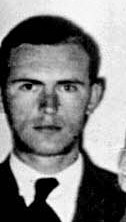Richard Schulze-Kossens
This article needs additional citations for verification. (April 2016) |
Richard Schulze-Kossens | |
|---|---|
 | |
| Born | 2 October 1914 Spandau, Berlin, Prussia, Germany |
| Died | 3 July 1988 (aged 73) Düsseldorf, North Rhine-Westphalia, Germany |
| Allegiance | |
| Service | |
| Years of service | 1934–1945 |
| Rank | Obersturmbannführer (lieutenant colonel) |
| Unit | Leibstandarte SS Adolf Hitler; Führerbegleitkommando; 38. SS-Grenadierdivision Nibelungen |
| Commands | 38. SS-Grenadierdivision Nibelungen |
| Awards | German Cross in Gold Order of the Cross of Liberty. |
Richard Schulze (2 October 1914 in Spandau, Berlin – 3 July 1988 in Düsseldorf) was a Waffen-SS officer during the Second World War who reached the rank of SS-Obersturmbannführer (lieutenant colonel). During World War II, Schulze served as a Waffen-SS adjutant to the foreign minister Joachim von Ribbentrop and later commanded the 38th SS Division Nibelungen, SS-Junkerschule Bad Tölz. He was awarded the German Cross in Gold and the Finnish Order of the Cross of Liberty.
Early life and SS service
Richard Schulze was born in Spandau, Berlin. A year after graduating from gymnasium in 1934, the 20-year-old Schulze entered the Allgemeine SS and was assigned to 6.SS-Standarte in Berlin. In November 1934, he served in the Leibstandarte SS Adolf Hitler (LSSAH), Adolf Hitler's bodyguard. Between 1935 and 1937 took various officer training courses at the SS-Junkerschule Bad Tölz, in Jüterbog and Dachau. In 1937, Schulze was reassigned to the 3.SS-Totenkopf-Standarte Thüringen where he served as an adjutant to Theodor Eicke. He is pictured standing with Molotov, Ribbentrop, Stalin and Soviet Chief of Staff Shaposnikov at the signing of the Molotov-Ribbentrop Pact of 23 August 1939. Later on he worked as an adjutant at the SS-Hauptamt (SS Head Office) for August Heißmeyer and the Foreign Minister Joachim von Ribbentrop.[1]
Second World War service
From October 1939 to August 1941, he was an SS-Ordonnanz-offizier for Adolf Hitler.[2] While serving in the role of an ordinance officer, he was also a member of the Führerbegleitkommando (FBK) which provided personal security protection for Hitler.[2] By 1944, he was promoted to the rank of SS-Obersturmbannführer (lieutenant colonel).[1] He later became the divisional commander of the 38th SS Division Nibelungen in 1945. At that time, Schulze was the commanding officer of the SS-Brigade Nibelungen and the SS cadet training school at Bad Tölz.[3]
Personal life
After the Second World War, Schulze changed his name to "Richard Schulze-Kossens". He was held in an American internment camp for three years. After being released, he worked as a salesman and wrote several books.[1] He appeared in the 26-episode television documentary, The World at War.
He remained in contact with a group of former adjutants, secretaries and other staffers who continued to have a favourable view of Hitler following the end of the war.[4] Schulze-Kossens died of lung cancer on 3 July 1988.[1] More than 100 former SS members attended his funeral, with many wearing the insignia of an SS veterans association, and his casket was draped with tributes from former SS units. Werner Grothmann and another former Nazi officer provided eulogies.[1]
Summary of SS career
Dates of rank
- SS-Anwärter: 11 November 1934
- SS-Junker: 1 April 1935
- SS-Standartenjunker: 11 November 1935
- SS-Standartenoberjunker: 2 February 1936
- SS-Untersturmführer: 20 April 1936
- SS-Obersturmführer: 11 November 1936
- SS-Hauptsturmführer: 1 August 1940
- SS-Sturmbannführer: 24 February 1943
- SS-Obersturmbannführer: 11 November 1944
Notable decorations
- Iron Cross Second (1940) and First (1940) Classes
- German Cross in Gold (1941)
- Close Combat Clasp in Bronze (1942)
- Infantry Assault Badge(1940)
- Wound Badge in Black (1941)
- Order of the Cross of Liberty 4th. Class (1942)
- SA-Sports Badge in Bronze (1937)
- Bulgarian Military Order for Bravery in War 4th Class (1st grade) – (1942)
References
Citations
- ^ a b c d e Associated Press (11 July 1988). "Richard Schulze-Kossens, Hitler Adjutant". The New York Times. Retrieved 9 January 2016.
- ^ a b Hoffmann 2000, p. 55.
- ^ O'Donnell 2001, p. 99.
- ^ Harris, Robert (2010). Selling Hitler: The Story of the Hitler Diaries. Random House. pp. 69–71. ISBN 9781409021957.
Bibliography
- Hoffmann, Peter (2000) [1979]. Hitler's Personal Security: Protecting the Führer 1921-1945. New York: Da Capo Press. ISBN 978-0-30680-947-7.
{{cite book}}: Invalid|ref=harv(help) - O'Donnell, James P. (2001) [1978]. The Bunker. New York: Da Capo Press. ISBN 978-0-306-80958-3.
{{cite book}}: Invalid|ref=harv(help) - Yerger, Mark C. (1997). Allgemeine-SS: The Commands, Units and Leaders of the General SS. Schiffer Publishing Ltd. ISBN 0-7643-0145-4.
{{cite book}}: Invalid|ref=harv(help) - New York Times Obituary: Monday, July 11, 1988 – http://www.nytimes.com/1988/07/11/obituaries/richard-schulze-kossens-hitler-adjutant.html
